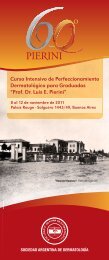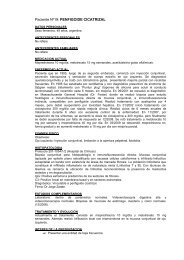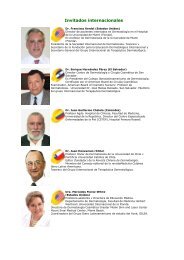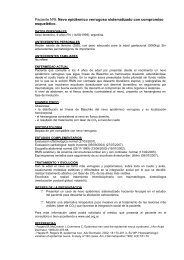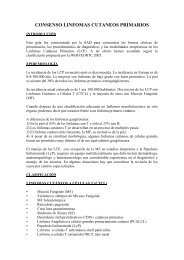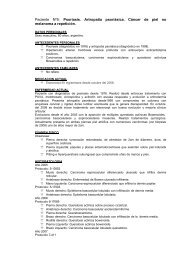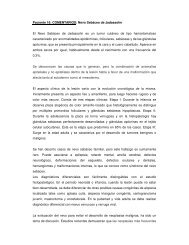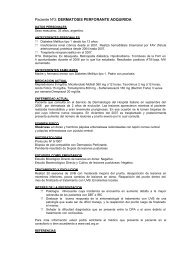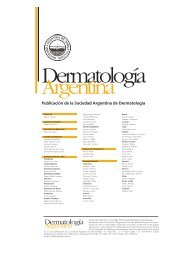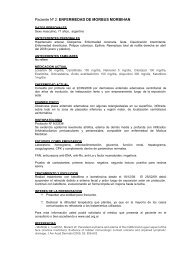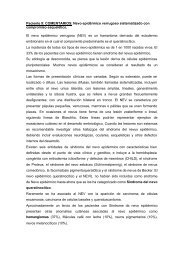Publicación de la Sociedad Argentina de Derm atolog à a
Publicación de la Sociedad Argentina de Derm atolog à a
Publicación de la Sociedad Argentina de Derm atolog à a
You also want an ePaper? Increase the reach of your titles
YUMPU automatically turns print PDFs into web optimized ePapers that Google loves.
Volumen VIII - Nº 5 - 2002<br />
D e rm<strong>atolog</strong>ía<br />
A rg e n t i n a<br />
Utilidad <strong>de</strong> <strong>la</strong><br />
d e rmatoscopía en el<br />
diagnóstico <strong>de</strong>l<br />
c a rcinoma basocelu<strong>la</strong>r<br />
D e rmatoscopy: a useful tool for the<br />
diagnosis of basal cell carc i n o m a<br />
Horacio Cabo*<br />
* Servicio <strong>de</strong> <strong>Derm</strong><strong>atolog</strong>ía - Hospital<br />
<strong>de</strong> Clínicas "José <strong>de</strong> San Martín"<br />
Fecha <strong>de</strong> recepción: 3/9/01<br />
Fecha <strong>de</strong> aprobación: 6/12/01<br />
Resumen<br />
La <strong>de</strong>rmatoscopía es una técnica no invasiva que<br />
mejora el diagnóstico clínico <strong>de</strong> <strong>la</strong>s lesiones pigmentadas.<br />
El diagnóstico <strong>de</strong>rmatoscópico se realiza en dos<br />
pasos o etapas. El primero consiste en diferenciar si<br />
una lesión es me<strong>la</strong>nocítica o no me<strong>la</strong>nocítica, y el<br />
segundo es diferenciar una lesión me<strong>la</strong>nocítica<br />
benigna <strong>de</strong>l me<strong>la</strong>noma.<br />
El carcinoma basocelu<strong>la</strong>r pigmentado es una <strong>de</strong> <strong>la</strong>s<br />
lesiones no me<strong>la</strong>nocíticas que se pue<strong>de</strong> confundir con<br />
un me<strong>la</strong>noma, <strong>de</strong>l que se consi<strong>de</strong>ra un simu<strong>la</strong>dor.<br />
Los criterios <strong>de</strong>rmatoscópicos <strong>de</strong>l carcinoma basocelu<strong>la</strong>r<br />
son:<br />
- Patrón vascu<strong>la</strong>r típico<br />
- Estructuras en forma <strong>de</strong> hoja o digitiformes<br />
- Nidos ovoi<strong>de</strong>s gran<strong>de</strong>s <strong>de</strong> color azul-gris<br />
- Múltiples glóbulos <strong>de</strong> color azul-gris<br />
- Áreas radiadas<br />
- Ulceraciones<br />
Con estos criterios diagnósticos, <strong>la</strong> sensibilidad <strong>de</strong>l<br />
método es <strong>de</strong>l 93% y <strong>la</strong> especificidad, <strong>de</strong>l 89%, por lo<br />
que su conocimiento nos permitirá mejorar el diagnóstico<br />
clínico <strong>de</strong> carcinoma basocelu<strong>la</strong>r (<strong>Derm</strong>atol<br />
Argent 2002; Nº 5: 256-259).<br />
Summary<br />
D e rmatoscopy is a non-invasive technique that<br />
improves the clinical diagnosis of skin pigmented<br />
lesions.<br />
The diagnosis can be ma<strong>de</strong> with the pro c e d u re<br />
known as two-step, where the first step is the differentiation<br />
between me<strong>la</strong>nocitic or non-me<strong>la</strong>nocitic<br />
lesions and the second step is the differentiation<br />
between benign me<strong>la</strong>nocitic lesions and me<strong>la</strong>noma.<br />
Basal Cell Carcinoma (BCC) es one of the nonme<strong>la</strong>nocitic<br />
lesions that can be misdiagonses as<br />
me<strong>la</strong>noma, and is consi<strong>de</strong>red one of the me<strong>la</strong>noma<br />
mimickers. This lesion meets typical <strong>de</strong>rmatoscopy criteria<br />
such as:<br />
- Typical vascu<strong>la</strong>r pattern<br />
- Leaf-like structures<br />
- Large blue-gray ovoid nest<br />
- Multiple blue-gray globulos<br />
- Spoke-wheel areas<br />
- Ulcerations<br />
With this methods the sensivility is 93% and the<br />
specificity is 89%.<br />
Knowledge of these criteria allows us to improve our<br />
clinical diagnosis of BCC.<br />
256



